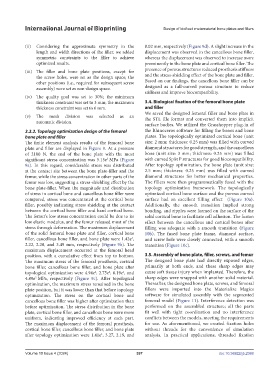Page 405 - IJB-10-4
P. 405
International Journal of Bioprinting Design of biofixed metamaterial bone plates and fillers
(ii) Considering the approximate symmetry in the 8.02 mm, respectively (Figure 9d). A slight increase in the
length and width directions of the filler, we added displacement was observed in the cancellous bone filler,
symmetric constraints to the filler to achieve whereas the displacement was observed to increase more
optimized results. prominently in the bone plate and cortical bone filler. The
(iii) The filler and bone plate positions, except for presence of porous structures reduced prosthesis stiffness
the screw holes, were set as the design space; the and the stress-shielding effect of the bone plate and filler.
other positions (i.e., required for subsequent screw Based on our findings, the cancellous bone filler can be
assembly) were set as non-design space. designed as a full-curved porous structure to reduce
stiffness and improve biocompatibility.
(iv) The quality goal was set to 30%; the minimum
thickness constraint was set to 3 mm; the maximum 3.4. Biological fixation of the femoral bone plate
thickness constraint was set to 6 mm. and filler
We saved the designed femoral filler and bone plate in
(v) The mesh division was selected as an the STL file format and converted them into implicit
automatic division.
surface bodies. We utilized the Grasshopper plug-in of
3.3.2. Topology optimization design of the femoral the Rhinoceros software for filling the bones and bone
bone plate and filler plates. The topologically optimized cortical bone (unit
The finite element analysis results of the femoral bone size: 2 mm; thickness: 0.25 mm) was filled with curved
plate and filler are displayed in Figure 9. At a pressure diamond structures for good strength, and the cancellous
of 2100 N, the end of the bone plate with the most bone (unit size: 3 mm; thickness: 0.25 mm) was filled
significant stress concentration was 5.15e MPa (Figure with curved Split P structures for good biocompatibility.
2
9a). In this regard, considerable stress was distributed After topology optimization, the bone plate (unit size:
at the contact site between the bone plate-filler and the 2.5 mm; thickness: 0.25 mm) was filled with curved
femur, while the stress concentration in other parts of the diamond structures for better mechanical properties.
femur was low, suggesting a stress-shielding effect by the The fillers were then programmatically fused with the
bone plate-filler. When the magnitude and distribution topology optimization framework. The topologically
of stress in cortical bone and cancellous bone filler were optimized cortical bone surface and the porous curved
compared, stress was concentrated at the cortical bone surface had an excellent filling effect (Figure 10a).
filler, possibly indicating stress shielding at the contact Additionally, the smooth transition implied strong
between the cortical bone filler and hard cortical bone. bonding, and ripples were formed on the surface of the
The femur’s low stress concentration could be due to its solid cortical bone to facilitate cell adhesion. The fusion
low elastic modulus, and the femur released most of the effect between the cancellous and cortical bones after
stress through deformation. The maximum displacement filling was adequate with a smooth transition (Figure
of the solid femoral bone plate and filler, cortical bone 10b). The fused bone plate frame, diamond surface,
filler, cancellous bone filler, and bone plate were 1.42e , and screw hole were closely connected, with a smooth
1
2.22, 2.20, and 3.49 mm, respectively (Figure 9b). The transition (Figure 10c).
maximum displacement occurred at the femoral head
position, with a cumulative effect from top to bottom. 3.5. Assembly of bone plate, filler, screws, and femur
The maximum stress of the femoral prosthesis, cortical The designed bone plate had directly exposed edges,
bone filler, cancellous bone filler, and bone plate after primarily at both ends, and these sharp edges may
topological optimization were 4.94e , 2.75e , 6.19e , and cause soft tissue injury when implanted. Therefore, the
2
2
1
4.89e MPa, respectively (Figure 9c). After topological sharp edges were wrapped with another solid material.
2
optimization, the maximum stress remained in the bone Thereafter, the designed bone plate, screws, and femoral
plate position, but it was lower than that before topology fillers were imported into the Materialize Magics
optimization. The stress on the cortical bone and software for simulated assembly with the segmented
cancellous bone filler was higher after optimization than femoral model (Figure 11). Interference detection was
before optimization. The stress distribution in the bone performed on the assembled structure; all the parts
plate, cortical bone filler, and cancellous bone were more fit well with tight coordination and no interference
uniform, indicating improved efficiency at each part. conflicts between the models, meeting the requirements
The maximum displacement of the femoral prosthesis, for use. As aforementioned, we created fixation holes
cortical bone filler, cancellous bone filler, and bone plate without threads for the convenience of simulation
after topology optimization were 1.41e , 3.27, 2.19, and analysis. In practical applications, threaded fixation
1
Volume 10 Issue 4 (2024) 397 doi: 10.36922/ijb.2388

